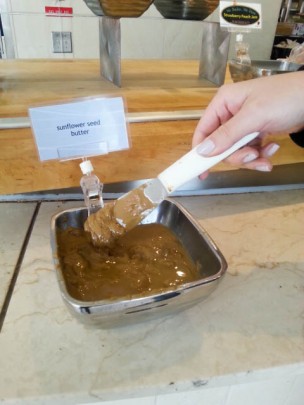
Nuts and non-dairy butter are two of my favorite things. But when it comes to nut butter, my all-time favorite, there’s nothing to be ambivalent about: They’re all delicious. Here’s a rundown of the six best nut butters, from peanut to pistachio, along with some key nutritional details.
The Butter: Peanut
The taste: You already know what peanut butter tastes like, so I don’t have to tell you that it’s heavenly in pretty much everything, from sandwiches to savory sauces to cookies. Peanut butter is a champion, endlessly flexible and unfailingly delicious on apples and bananas. There is a wide range of peanut butters available for purchase in grocery stores, from sugar-packed brands to all-organic oily ones that you should definitely stir before consuming (take it from someone who learned the hard way). Peanut Butter & Co., based in New York City, sells many exciting varieties of peanut butter, such as White Chocolate Wonderful, Dark Chocolate Dreams, and Cinnamon Raisin Swirl. Yum!
Nutrition: PB is chock full of fiber and the antioxidant vitamin E, as well as ingredients that reduce the risk of heart disease and diabetes. It’s also got monounsaturated fat, which is wonderful for your heart. Just don’t buy the reduced-fat version: Companies trade healthy fat for sugar and pretend they’re being noble. Another thing to watch out for when buying peanut butter is sodium, which can add up, especially in some big-name brands. Want to be extra sure that you’re comfortable with what you’re putting in your body? Make your own peanut butter by putting peanuts, salt, and honey (if you eat it) into a food processor and drizzle in oil until it’s smooth.
The Butter: Almond
The taste: Almond butter tastes like little more than ground-up almonds, and for good reason: It’s sold mostly by natural brands that don’t add other ingredients to their products. Almond butter is ace in oatmeal and with granola. An up-and-comer in the nut butter world, this butter is now available at most grocery stores, sold by companies such as Maranatha and Jif. Earthy, rich, and somewhat grainy, almond butter is a solid choice for your discerning palate.
Nutrition: Another top-notch source of mono- and polyunsaturated fats, almond butter is an omega-3 and omega-6 all-star. It doesn’t have quite as much protein as peanut butter does, but hey: You can’t always have your nut butter and eat it, too. Besides, almond butter wins out in terms of vitamin E and magnesium, not to mention iron.
The Butter: Cashew
The taste: There’s a reason that so many vegans use ground cashews in place of cheese in many savory dishes: They’re rich, creamy, and decidedly cheesy. Some chefs, though, have prepared it with honey to produce a sweet mixture. Cashew butter is a dream come true when included in recipes for anything from cookies to salad dressing. In a sandwich, it’s probably best paired with bananas.
Nutrition: Modest in protein, with six grams per serving, and a good source of heart-healthy fats, cashew butter is a fine and upstanding choice. It’s no almond butter, of course, but we can’t all be almond butter. Be sure to check the sugar content on a store-bought jar, though: Some manufacturers add the stuff like it’s water.
The Butter: Sunflower Seed
The taste: My personal favorite of all the butters listed here, sunflower seed butter is sweet, grainy, and just a little bit playful. I could eat the stuff all day (but don’t…usually). Sunflower seed butter is not technically a nut butter, but as it’s included in the Usdan spread, it counts in my book. It’s fantastic when mixed with granola, eaten with fruit (fresh or dried), or just lapped up from a spoon. Oh, and you haven’t lived until you’ve had a sunflower-seed-butter-and-honey sandwich, preferably on some nice bread.
Nutrition: Another choice that’s a good protein source and an ideal way to get those healthy fats, sunflower seed butter delivers fiber, magnesium, niacin, and antioxidant vitamin E. Pro tip: Take a few tablespoons in a bowl and then sprinkle in some of the crushed Heath Bar that Usdan sometimes places near the ice cream. Add some granola to that, and then some dried fruit, and you’ll basically have reached Nirvana.
The Butter: Hazelnut
The taste: Hazelnut butter is one of the building blocks of Nutella, so you already know it’s good. On the positive side, it doesn’t have all the sugar and milk that’s needed to make Nutella, but on the negative, it’s not Nutella and honestly doesn’t hold a candle to it. But fear not: Hazelnut butter is delicious. Low-key and delightfully adaptable, it’s a prime choice on toast with jam.
Nutrition: With only half as much protein as peanut butter, hazelnut butter makes up for its deficits in omega-6 fatty acids, fiber, vitamin E, copper, and manganese. If you’ve got to just go for the Nutella and won’t have it any other way—we all have those days—rest assured that the addition of chocolate and milk doesn’t necessarily mean that these nutritional benefits will be lost!
The Butter: Pistachio
The taste: Delightfully and wickedly green, pistachio butter is a treat for its richness. Spread it onto some thick toast and add a bit of jam, if you want: Few things are better. The only issue with pistachio butter is that you might have to make your own (most of the available store-bought brands cost upwards of $15, and we both know that I’m not suggesting you pay that). But for those who aren’t afraid of a challenge, simply roast pistachios and process them with some salt. And if you’re feeling extra fancy, add some maple syrup; I’m told by the vegan blogging world that it’s divine.
Nutrition: Pistachio butter is not only an excellent source of omega-6 fatty acids, fiber, and potassium, but also a modest source of protein. Greatist.com suggests boiling pistachios and almonds and then mixing them with some sugar for optimal protein consumption.



Leave a Reply